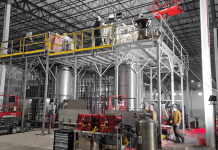

Jim Paetsch works every day with business owners looking to expand, relocate or build a new facility. The vice president of corporate relocation, expansion and attraction for Milwaukee 7 (M7) said owners consider a lot of factors before making a final decision, including location, financing options and the impact on workers and customers.
Once business owners decide on their expansion plans — whether it is building a new facility or expanding a current one – they should begin to look at financial incentives, Paetsch said. While Wisconsin and local municipalities have multiple programs available, it is not a given businesses will receive tax credits or funding.
“As a general rule of thumb, the state is willing to trade incentives for job creation, while local municipalities are willing to trade incentives for increased property-tax base,” he said. “Adding new jobs or retaining them is critical to receiving any incentive.”
On the state level, the Wisconsin Economic Development Corp.’s Business Development Tax Credit Program provides companies with refundable tax credits to help reduce their state income tax liability or provide a refund, which improves overall cash flow.
On the local level, Paetsch said municipalities also consider a company’s real estate footprint, since that increases the tax base. Some ways cities and villages can help businesses include incentives or funding packages, whether through the creation a tax incremental financing (TIF) district or through a revolving loan fund.
Looking at different incentives can be time-consuming and confusing for business owners, which is why one of M7’s goals is to connect relocating and expanding businesses with state and local funding, Paetsch said. “We are a one-stop shop to help businesses navigate the various programs,” he said.
M7’s staff helps business owners find their way through the myriad available incentives by:
- Framing the story: M7 works with businesses to “tell their story,” Paetsch said. Business owners need to explain what their company does, their plan for growth and how that growth helps the state or municipality.
- Forming connections: M7 helps business owners connect with the right person at the state or local level regarding incentives.
- Coaching on the right approach: Businesses need to look at incentives as a benefit to not only themselves, but the larger community. According to Paetsch, coming to the table with that mentality can help businesses looking for tax credits or financing assistance. “If we are working with a business looking to relocate and the first thing mentioned is incentives, that’s a warning sign,” he said. “Businesses should look at location, workforce and those issues first before asking about incentives.”
- Knowing the rules: The state monitors businesses receiving tax credits to make sure they live up to their end of the bargain. Paetsch walks business owners through the application process and makes sure they know what needs to be done once funds are received.
“Incentives are not entitlements,” he said. “Companies need to be able to clearly demonstrate why taxpayer dollars are better spent on them versus a competing project.”
What is a TIF?
|
|---|
| Tax incremental financing (TIF) is the most powerful tool that local municipalities have when it comes to development. TIFs are a governmental finance tool that cities and villages can use to provide funds to build public infrastructure, promote development opportunities and expand the future tax base. Cities cite expanding the future tax base when they use a TIF to help a business with financing an expansion project. |




